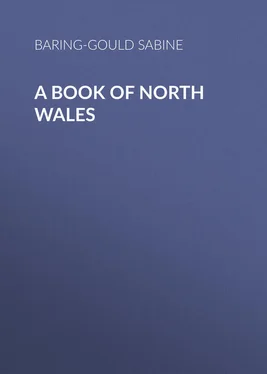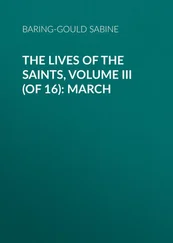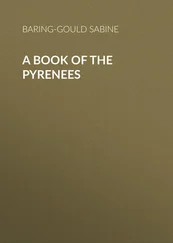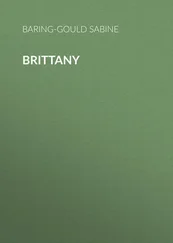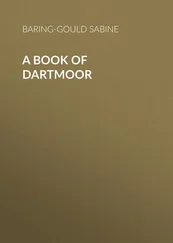Sabine Baring-Gould - A Book of North Wales
Здесь есть возможность читать онлайн «Sabine Baring-Gould - A Book of North Wales» — ознакомительный отрывок электронной книги совершенно бесплатно, а после прочтения отрывка купить полную версию. В некоторых случаях можно слушать аудио, скачать через торрент в формате fb2 и присутствует краткое содержание. Жанр: foreign_antique, foreign_prose, на английском языке. Описание произведения, (предисловие) а так же отзывы посетителей доступны на портале библиотеки ЛибКат.
- Название:A Book of North Wales
- Автор:
- Жанр:
- Год:неизвестен
- ISBN:нет данных
- Рейтинг книги:4 / 5. Голосов: 1
-
Избранное:Добавить в избранное
- Отзывы:
-
Ваша оценка:
- 80
- 1
- 2
- 3
- 4
- 5
A Book of North Wales: краткое содержание, описание и аннотация
Предлагаем к чтению аннотацию, описание, краткое содержание или предисловие (зависит от того, что написал сам автор книги «A Book of North Wales»). Если вы не нашли необходимую информацию о книге — напишите в комментариях, мы постараемся отыскать её.
A Book of North Wales — читать онлайн ознакомительный отрывок
Ниже представлен текст книги, разбитый по страницам. Система сохранения места последней прочитанной страницы, позволяет с удобством читать онлайн бесплатно книгу «A Book of North Wales», без необходимости каждый раз заново искать на чём Вы остановились. Поставьте закладку, и сможете в любой момент перейти на страницу, на которой закончили чтение.
Интервал:
Закладка:
We can determine with some confidence the spot where Agricola stood contemplating the last stronghold of the Briton and its defenders. It was at Dinorwic, where now plies a ferry.
He waited till the strong current of the tide had run to exhaustion and left a long stretch of sand on the further side. The Britons seeing that he was without ships feared nothing.
But they were speedily convinced of their mistake. Agricola’s auxiliaries, probably natives of the low lands at the mouth of the Rhine, had no fear of the water, plunged in, and gallantly swam across the channel.
A massacre ensued; the island was subjugated, and Roman remains found on it in several places testify that the conquerors of the world planted troops there in camp to keep Mona in complete control. They worked the copper mines near Amlwch.
As the Roman power failed in Britain, Mona became the stronghold of the invading Gwyddyl or Irish; they held it, and erected on its commanding heights their stone-walled fortresses, and it was not till the time of Caswallon Long-hand, grandson of Cunedda, that they were dislodged. He fought them in a series of battles, drove them from their strong castles faced with immense slabs of granite, such as Tin Sylwy, swept them together into Holy Island, then broke in on their last remaining fortress. According to legend, Caswallon was obliged to fasten his Britons together with horse-hobbles, to constrain them to fight by taking away from them the chance of escape by running away. With his own hand he slew Serigi, the Irish chief, near the entrance to the camp, and those of the Gwyddyl who did not escape in their boats were put to the sword. By an odd freak much like ours in glorifying De Wet and Lucas Meyer, the Welsh agreed to consider their late enemy as a martyr, and a chapel was erected where he fell, and he is figured, very shock-headed and bearing the short sword wherewith he was killed, in a niche of the doorway of the church which now stands in the midst of the old Gwyddyl fortress.
Caswallon set up his residence on the hill above Llaneilian, where the foundations may still be traced – a spot whence in the declining day the mountains of Wicklow may be seen, the Isle of Man stands out to the north, and in clear weather Helvellyn may be distinguished on the rim of the blue sea.
Edwin, king of Northumbria, conquered both Mona and the Isle of Man in 625. The place of his landing is still pointed out at Lleiniog, near Beaumaris, and a mound of the Anglo-Saxon type remains to show where was his first camp. Here also Hugh the Fat, Earl of Chester, was killed by the arrow of Magnus Barefoot. But of this more presently. Driven from Deganwy, on the Conway, the kings of Gwynedd made their residence at Aberffraw, in Mona. Of that palace there are but scanty traces.
There is something remarkable in the character of Anglesey. The bold mountains of Wales come to an abrupt fall at the Menai Straits, and thence the island stretches west in low undulation rising nowhere to any considerable elevation, and scored across with depressions from north to south, feeble and imperfect replicas of the Menai Straits. One is the furrow occupied by the Malldraeth morass and sands, but this does not cut completely across the island. The other is more thorough; it severs Holy Island from the main body of Môn, but it is so narrow that it has been bridged at Penybont and the railway crosses it on a causeway at Valley.
Anglesey does not impress the visitor as being so fertile as has been supposed. There are long stretches of morass and moor strewn with pools. But perhaps Môn was first called the “Mother of Wales” because to it, as to a mother’s lap, retreated the Cymry when beaten, wounded, and sore before their oppressors. If so, it soon ceased to be their place of refuge, but formed a point d’appui for their enemies, whence to strike at them from the rear.
Mona, as already said, does not present us with very striking scenery, except on the coast, but it teems with interest in other ways. It is dotted with monuments of the primeval inhabitants – cromlechs and meini-hirion (the plural of maen-hir). It possesses very well preserved camps of the Gwyddyl invaders. It was first the sanctuary and school of the Druids, and after that, of their spiritual successors, the Saints. The slope of Mona towards the east is well timbered and studded with mansions, the park of Plas Newydd, the residence of the Marquess of Anglesey, Plas Llanfair, and the palace of the Bishop of Bangor. This prelate had his residence near the Cathedral, but this has been sold, and a lordly mansion has been given to him on the Straits, where he can turn his back on his Anglesey clergy, and say to the rest, “Between us and you there is a great gulf fixed.” The beautiful suspension bridge erected by Telford crosses the Straits at their sweetest spot. Here the channel is broken by a little island occupied by the graveyard and church of Llandyssilio. The church is of no architectural interest. It was founded by Tyssilio, one of the sons of Brochwel Ysgythrog, prince of Powys, when he ran away from Meifod to escape the blandishment of an over-affectionate sister-in-law.
Llansadwrn Church, beautifully situated and carefully restored, contains the tombstone of its patron saint. This is a small block, now broken, that was found under the wall of the north transept, and is now let into the side of the chancel. It bears the inscription: Hic Beatu(s) Saturninus Se(pultus I)acit. Et Sua Sa(ncta) Coniux. P(ax) . The knight was an Armorican prince, and the brother of S. Illtyd, founder of Llantwit Major, in Glamorganshire. Sadwrn and his wife Canna, who was his cousin, left Armorica, owing probably to some family unpleasantness. After his death she married again, and became the mother of Elian the Pilgrim, of whom we shall have something to say presently. In the very interesting church of Beaumaris is a tomb the sides of which are decorated with delicately carved figures of Anglesey saints, and among these are two that may be taken to represent Sadwrn and his wife. He is shown in armour, his sword sheathed, and holding a pilgrim’s staff in his left hand, whilst giving a benediction with the right.
When the tubular bridge for the railway was built it was considered that a prophecy made by a Welsh bard had been fulfilled, wherein he spoke of rising from his bed in Mona, of breakfasting in Chester, of lunching in Ireland, and of returning to sup in Mona. But the required speed to Ireland has not yet been attained. Another meaning or interpretation has been put on the words of Robyn Ddu. He was living at Holyhead when he wrote the lines in question, and there were two boats by the quay, one from Chester and the other from Dublin, and he breakfasted with the captain at his table in the first boat, took his midday meal in the cabin of the second, and returned to his own quarters to sup and sleep.
Beaumaris is a sleepy little place, only waking to life when the bathing season sets in. The castle was erected by Edward I., and took its name from its situation on the Fair Marsh. It is not a particularly striking building, and is far gone in ruin.
The church, however, which is of the same period, and due to Edward I., is worth a visit. The side aisles contain five two-light Decorated windows. The chancel is Late Perpendicular, with a very poor east window containing some fragments of stained glass. The arcade of the church is Perpendicular. In the vestry are Bulkeley monuments, removed at the Dissolution from Penmon. From Beaumaris a delightful excursion may be made to Penmon, which was a great nursery of saints for Gwynedd. It would be hard to find anywhere a sweeter or sunnier spot. The hills fold around the little dell in which lies the church, shutting off the gales from north and east and west, and open only to the south to let in the sun.
Читать дальшеИнтервал:
Закладка:
Похожие книги на «A Book of North Wales»
Представляем Вашему вниманию похожие книги на «A Book of North Wales» списком для выбора. Мы отобрали схожую по названию и смыслу литературу в надежде предоставить читателям больше вариантов отыскать новые, интересные, ещё непрочитанные произведения.
Обсуждение, отзывы о книге «A Book of North Wales» и просто собственные мнения читателей. Оставьте ваши комментарии, напишите, что Вы думаете о произведении, его смысле или главных героях. Укажите что конкретно понравилось, а что нет, и почему Вы так считаете.
